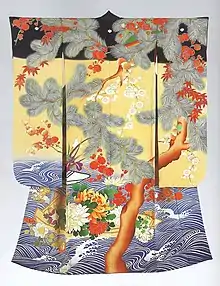Yūzen
Yūzen (友禅染) is a Japanese resist dyeing technique involving the application of rice paste to fabric to prevent colour transfer of dye to areas of the fabric. Originating in the 17th century, the technique became popular as both a way of subverting sumptuary laws on dress fabrics,[1] and also as a way to quickly produce kimono that appeared to be hand painted with dyes. The technique was named after Miyazaki Yūzen, a 17th-century fan painter who perfected the technique.

.Detail._Matsuzakaya_Collection.jpg.webp)
Technique
The yūzen technique involves making a rough draft with an easily washed-out liquid dye, after which the paste is applied over the lines of the draft, to prevent colours from mixing. The next step involves filling in the empty areas, after which the paste (and the removable dye) are washed out.[2]
Though similar in appearance to tsutsugaki, yūzen differs in application, with tsutsugaki pieces generally using one application of rice paste before dyeing, typically in an indigo dyebath, resulting in a characteristic blue and white end result. In contrast, yūzen can feature a number of repeated applications of rice paste, with dye hand painted into certain areas before the resist is removed.
Present day
Yūzen continues to be a popular decoration technique for kimono and obi, typically used for more formal outfits, and commonly seen on kimono such as kurotomesode. Unlike other kimono dyeing techniques such as tsujigahana, yūzen has never fallen out of fashion or been forgotten as a textile decoration technique. Dyers such as Moriguchi Kako of Kyoto continue to create yūzen dyed kimono, which were so sought after that the contemporary fashion industry designed an industrial method to copy them for use on Western style clothing. Famous designers, such as Hanae Mori, borrowed extensively from kimono patterns for their couturier collections. By the late 1980s, an elegant, handwoven and hand dyed kimono had become extremely costly, running to US$25,000 for a formal garment.
In Okinawa, yūzen techniques have also been used to produce the stencil dyed bingata fabric native to that region, producing brightly coloured textiles considered to be artistic national treasures.
Yūzen variations
Birodo yūzen, or yūzen birodo, is a yūzen technique where velvet is dyed and painted with the yūzen technique, after which the pile is cut away carefully in certain places, creating a painterly effect of light and shade.[3] The technique first appeared in the nineteenth century and was described in 1905 by Basil Hall Chamberlain.[4] Although technically a form of velvet painting, birodo yūzen works are not not comparable to Western and Middle Eastern velvet paintings, which utilise velvet as a canvas.
See also
- Rōketsuzome, a traditional Japanese wax resist dye technique
- Katazome, a traditional stencil resist dye technique
- Tsutsugaki, a hand applied dye resist technique similar to yūzen
References
- Condra, Jill (2008). The Greenwood Encyclopedia of Clothing Through World History. Greenwood Publishing Group. ISBN 9780313336645.
- https://digitalcommons.unl.edu/cgi/viewcontent.cgi?article=1474&context=tsaconf The Evolution of Yuzen-dyeing Techniques and Designs after the Meiji Restoration. 2004
- "Takeuchi Seiho (after), Moon over Venice, a textile wall hanging". British Museum. British Museum. Retrieved 24 August 2012.
- Chamberlain, Basil Hall (1905 (republished 28 February 2009)). Things Japanese : being notes on various subjects connected with Japan for the use of travellers and others. J. Murray, London (republished by Echo Press, 2009). ISBN 9781848301818. Check date values in:
|date=(help)
External links
 Media related to Yūzen at Wikimedia Commons
Media related to Yūzen at Wikimedia Commons